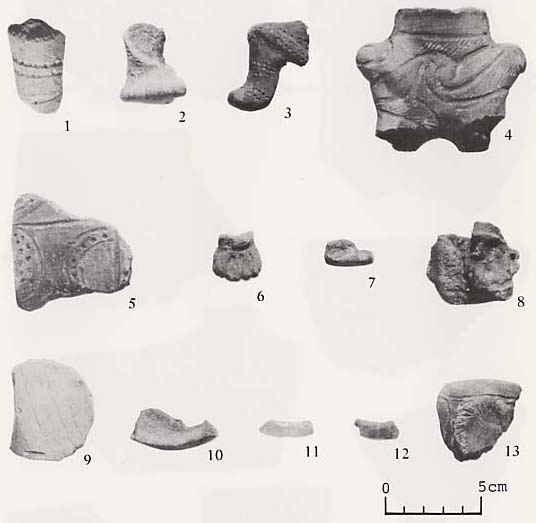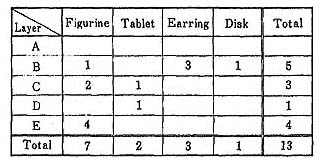CHAPTER VIII CLAY ARTIFACTS (NOT POTTERY)
|
Thirteen clay artifacts other than pottery were collected. They are classified as figurines, tablets, earrings and a disk. 1. Classification(a) FigurinesSeven fragments were found. The one nearly complete is missing only the head and legs (Fig. 14:1, Plate XX:4), The entire surface is decorated. The basic pattern of decoration consists of straight and curved, incised lines, 1-3 mm in width and 1-2 mm in depth, creating zones of cord marked or smoothly polished surfaces. An important decoration motif is the spiral pattern.
Of the six fragments one is thought to be part of a head (Fig. 14:7, Plate XX: 8), one an arm (Fig. 14:3, Plate XX:3) and the other four are probably parts of legs (Fig. 14:2, 4-6, Plate XX:1, 2, 6, 7). The arm and legs all have decorations. The techniques used in these decorations are straight and curved, incised lines, 1-2 mm in width, circular dots, 1 mm in diameter and depth, and incision-and-dot designs (Fig. 14:5). (b) Tablets.Two fragments were collected. One of them is decorated on both sides, with straight and curved lines, 1-3 mm wide and 1-3 mm deep, and dots. 2-3 mm wide and deep (Fig. 15:1, Plate XX: 5). The basic motif seems to be semicircular and curved zones of punctuations, 8-10 mm in width, but the complete motif cannot be seen because the piece is a fragment.
The other one is a small fragment only tentatively identified as a tablet (Fig. 15:3, Plate XX; 13). It is decorated on both sides with incised lines, 1-1.5 mm wide and 1 mm deep. On one side is a crater-shaped low relief about 3 cm in diameter with scratched lines on its ridge. (c) EarringsThree pieces belong to this group. All are ring-shaped fragments (Fig. 15:4-6, Plate XX;10-12) (d) DiskThis artifact was produced by grinding and polishing the edges of a potsherd to make it round in outline. There are shallow incised lines, 0.5-1 mm wide, on the upper surface. These lines are part of the original pot decoration. 2. Remarks on the Clay Artifacts; Frequency by LayerAs with artifacts of other materials, clay artifacts are relatively greatest in quantity in Layer E (Table 13).
|



